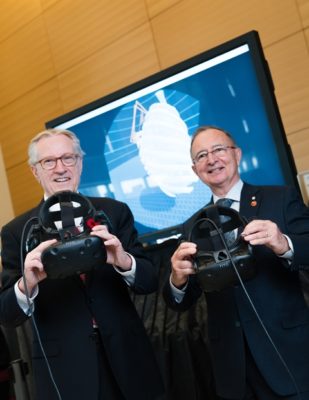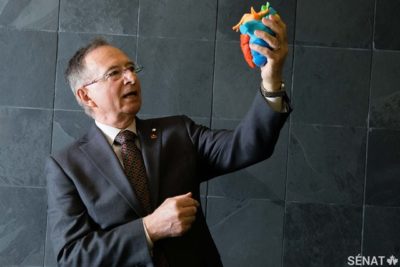By Senator Kelvin Kenneth Ogilvie and Senator Art Eggleton, P.C.
It isn’t news to anyone in the medical community that Canada is a sprawling country covered by healthcare systems that sit at the core of our national values but are struggling to meet the needs of a growing and aging population.
The system is financially stretched and expensive — $228 billion a year and increasing at a rate of 2.7 per cent annually — and as all hospital employees experience on a daily basis, struggling to meet the needs of the people it’s meant to serve.
But here’s some good news.
Artificial intelligence (AI), robotics and 3D printing have progressed by leaps and bounds.
While technological innovations are slowly becoming part of some medical treatments, it is also true that the healthcare system has yet to fully adjust to the notion of ‘automation,’ let alone prepare for it.
By ‘automation,’ we mean a myriad of innovations with the potential to cut costs, make treatments and diagnoses quicker, easier and more accurate, and create a system that routinely goes to the patient rather than the other way around.
These technologies will help with hospital workflows and management. In home care, wearable devices and sensors will assess and predict patient needs while personal robots will relieve home care helpers from many menial tasks.
So how do we ensure that advanced technology and the healthcare system grow together in harmony while keeping Canadians healthy, and successfully treating those who need care in a timely manner?
This was the starting point for the Senate Committee on Social Affairs, Science and Technology when we began our study this year on the use of robotics, artificial intelligence and 3D printing in healthcare.
Between February 1 and May 15, 2017, we met a dozen times, went on two fact-finding site visits and heard from hospital administrators, surgeons, researchers, research funders, ethicists, entrepreneurs, engineers and healthcare providers.
Our final report, released on October 31, is titled Challenge Ahead: Integrating Robotics, Artificial Intelligence and 3D Printing Technologies Into Canada’s Healthcare Systems.
Our overarching conclusion? The topic is complicated, but if our 14 recommendations could be boiled down to one sentence, this would be it: With the will and support of the federal government and ongoing productive partnerships among stakeholders, we can find a way to make this integration work for the well-being of all Canadians.
 In healthcare, robotics are already used in laboratory and pharmacy automation, surgery, exoskeletons, rehabilitation needing physical therapy and the daily well-being of the elderly and disabled.
In healthcare, robotics are already used in laboratory and pharmacy automation, surgery, exoskeletons, rehabilitation needing physical therapy and the daily well-being of the elderly and disabled.
Work in artificial intelligence began in the early 1960s, but rapid developments in computer capacity and the advent of the home computer and the internet saw a surge of interest in the 1990s. But as one leading expert told us: “Artificial intelligence is only artificial intelligence until some critical mass understands how it works. Then it’s just a computer program. It’s nothing more.”
Uses for artificial intelligence already include speech therapy, diagnostics, and blood tests.
3D printing isn’t printing, as we know it and can more accurately be described as ‘additive manufacturing.’ It uses a range of plastics and metals, cells and other biological materials to build a layered 3D object. In medicine we’re seeing 3D printing used in the building of prototypes for surgical planning, designing implants, producing prosthetics and orthotics and regenerating tissues and organs.
The report is the latest in a series of healthcare studies undertaken by our committee. We have examined and reported on obesity and dementia and the increasing needs of an aging population and lifestyle choices as they relate to chronic disease. All these can be accessed through links we have attached to this article.
The Challenge Ahead, as we will call it, casts us into the future but a future with a strong-enough connection to the here and now to convince us that our hospitals — indeed, all our healthcare components — need to prepare for significant change.
We refer to it as a ’transformative technological revolution’ and while that sounds dramatic, it is an apt phrase to describe what lies ahead.

Our report won’t give you all the answers because nobody has all the answers. But our research and the witnesses who appeared before our committee left us convinced that, as a country, the better we prepare, the more beneficial these amazing, emerging technologies will be for all Canadians.
They will:
- Increase speed and accuracy in diagnosis
- Transform home healthcare and provide surgeons with the tools to operate remotely
- Mean less invasive surgical procedures
- Offer Canada the opportunity to build a better, more efficient, less costly healthcare system.
Robotics, artificial intelligence and 3D printing will eventually take us to a place where the average person will be able to anticipate his or her own heart attack, get immediate notice of insulin deficiency or get body parts artificially renewed and replaced in hours.
People will want the same service on their bodies as they get now for their cars. Whatever the ailment, they will want it fixed today — not months or even years from now.
Currently, you might have the most brilliant surgeon on the planet, but there is no guarantee you will get to see him or her before it’s too late.
With the arrival of artificial intelligence in medicine, people will be even less willing to wait for treatment and it’s going to take planning and a significant change in institutional culture if our current system is going to cope.

During our work for this report, we witnessed the 3D production of a brace for a broken knuckle. It took 15 minutes using a portable machine. It is staggering to imagine what the capabilities of 3D production will be 10 or 20 years from now.
Canadian researchers have done amazing work in getting us to this stage. We must nurture that energy and innovation and capitalize on it.
Our primary recommendation is for the federal government to convene a recurring national conference that would include a broad range of professionals from the healthcare system, government, Indigenous communities and, of course, those who are developing and refining the technologies.
That initial conference would create expert working groups representing the various stakeholders and a secretariat to co-ordinate the ongoing work and report progress to the federal government.
We chose this route because of the need for Canada to stay on the leading edge of these technologies and to monitor the ethical and social challenges they will undoubtedly unleash.
Patient privacy is an obvious concern for us and so is the need for humans to remain in control. We envision robots as mechanical assistants to healthcare and social workers, relieving them of many routine, menial tasks.
Within the healthcare system, there will be job losses, jobs created and tasks within existing jobs that will change. The technological revolution that society in general has experienced during the past two or three decades has shown those types of changes to be inevitable.
Robots should not be in charge. They should be our assistants and our servants, but we must learn to trust them, or rather the artificial intelligence that drives their ‘thought’ processes. Physicians need to prepare for, and accept, contrary opinions and patients will need to understand that on occasions, the doctor might be wrong and the robot might be right.
Education and training will be fundamental to building this trust.
What we heard and saw from a variety of witnesses was enough to convince us that sitting back and waiting for change to happen is not an option. We have to be proactive, and we have to be prepared.
The Hon. Kelvin Kenneth Ogilvie, who retired from the Senate in November, was chair of the Senate Committee on Social Affairs, Science and Technology. Senator Art Eggleton, P.C., is its deputy chair.


